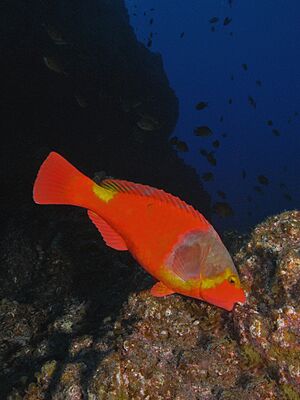Sparisoma cretense facts for kids
Quick facts for kids Sparisoma cretense |
|
|---|---|
 |
|
| Adult Male, Faial, Azores | |
 |
|
| Adult Female, El Hierro, Canary Islands | |
| Conservation status | |
| Scientific classification |
The Mediterranean parrotfish (Sparisoma cretense) is a colorful fish found in the Mediterranean Sea and the eastern Atlantic Ocean. It lives near rocky shores, usually in waters up to 50 m (160 ft) deep. You can find it from Portugal down to Senegal.
This fish is quite common in many areas. However, it is less common in the northwestern Mediterranean and the Adriatic Sea. It likes warmer waters, and scientists believe it is moving further north because of global warming. Adult parrotfish mostly live on rocky reefs, especially where there are lots of macroalgae (large seaweeds). They might also visit nearby seagrass beds. Young parrotfish, called juveniles, are often found in these seagrass areas.
The Mediterranean parrotfish is sometimes caught by people for food. Even though some groups of these fish are affected by fishing, they are not considered an endangered species. Scientists have studied them closely in places like the Azores.
Contents
What it Looks Like
The Mediterranean parrotfish changes its appearance as it grows. It also has an interesting way of changing sex. Many parrotfish start as females and then become males later in life. For this species, some females stay female their whole lives. Others change from female to male while they are still young and not yet reproducing. This means you won't see males that look like females in this species.
Very young parrotfish, less than 7 cm (3 in) long, have a yellowish head and a mottled body. They are not yet male or female. As they grow to 7–12 cm (3–5 in) long, they become mottled brownish. These are immature females. If they get scared or stressed, they can quickly change their pattern to show wide white stripes.
When they get bigger, they develop their adult colors. Adult females are mostly red. They have a greyish, saddle-shaped mark on their back with yellow edges. They also have a yellow spot near the base of their tail. Adult males are generally greyish with lighter undersides. They don't have many distinct marks, but often have dark bars on their throat and gill cover.
Adult Mediterranean parrotfish can grow up to about 52 cm (20 in) long. However, most are usually between 15–30 cm (6–12 in) long. Both males and females can be similar in size, but males are typically a bit larger on average.
Where it Lives and What it Eats
The Mediterranean parrotfish is a busy eater! It mainly feeds on algae that grows on rocks, especially hard, crusty algae called coralline algae. It also eats algae that grows on seagrass. Sometimes, it will even snack on small invertebrates, which are tiny animals without backbones.
This fish has special jaws and teeth that are perfect for scraping algae off rocks. Their strong teeth help them munch on tough plant material.
Life Cycle and Reproduction
Mediterranean parrotfish are active during the day. They usually breed in the summer, from July to September. However, they can sometimes breed earlier, in May, or later, in December. Spawning, which is when they release their eggs and sperm, often happens around sunrise or sunset. They can spawn in pairs or in larger groups.
After the eggs are released, they float freely in the open water. These eggs hatch into tiny, free-swimming larvae. The eggs and larvae spend about 50 to 60 days floating in the ocean. After this time, they settle down onto rocky reefs or into seagrass beds, where they continue to grow into young fish.
Parrotfish and People
In some places, like the Canary Islands, people catch the Mediterranean parrotfish using spears. In other areas, it might be caught by accident when fishermen are trying to catch other types of fish. When this happens, it's called "bycatch," and these parrotfish are then sold in markets.
Images for kids
-
A young Mediterranean parrotfish in Koufonisi, Greece.
-
Mediterranean parrotfish for sale at a fish market in Playa Blanca, Lanzarote, Canary Islands, Spain.





